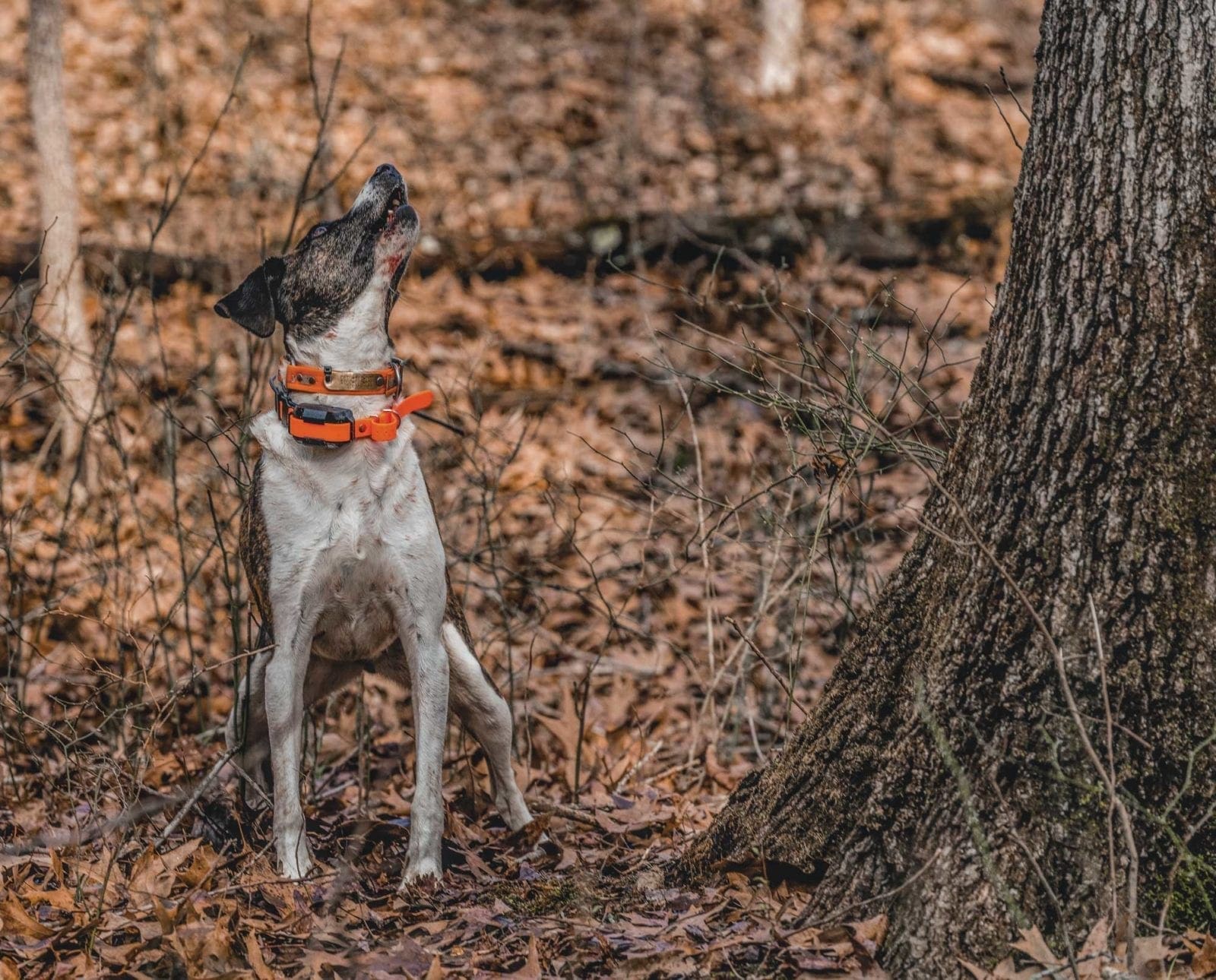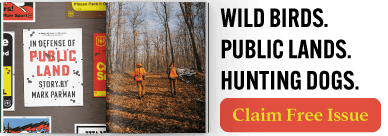Home » Small Game Hunting » Squirrel Hunting » How to Hunt Squirrels with a Dog
How to Hunt Squirrels with a Dog

Marc Gray has been hunting squirrels for nearly 30 years…
Hunting with a purpose-bred squirrel dog is fun, family-friendly, and an easy way to extend your hunting season
The close relationship between dog and hunter is ancient. Even in what is now the United States, squirrel dogs have been helping us fill the game bag for hundreds of years. Having a good dog will assist in locating game when it’s difficult to pinpoint a food source, eliminate large patches of forest as not having game available for harvest, alert you of danger or an oncoming hunter, which improves safety, and reduce crippling losses by tracking and finding shot game.
Gear for squirrel hunting with a dog
First things first: buy a hunting license. I often run into people that do not realize that squirrels are a regulated game animal with a season and bag limit. It is always wise to read up on local hunting regulations. Fees from licenses are what drives conservation in the U.S. In 1937, hunters lobbied for a self-imposed excise tax on sporting equipment called the Pittman-Robertson (PR) Act. PR funds are reallocated back to the states to purchase Wildlife Management Areas and otherwise run state wildlife programs. Squirrel hunting has a season and requires a license in most places. Not sure if your state requires it? Buy one anyway to support stewardship of natural resources.
Standard equipment for hunting with squirrel dogs includes a sturdy dog box or crate for your vehicle, reflective collars with name plates, durable leads, a dog tracking system (usually GPS-based), first-aid supplies, a blaze orange vest with game pouch, and your rifle or shotgun of choice.
Best dog breeds for hunting squirrels
Hunting squirrels is what dogs like the Mountain Cur, Mountain Feist, Treeing Cur, Treeing Feist, West Siberian Laika, Coonhound-bird dog crosses, and about a dozen other breeds you might encounter in the timber were bred to do. Basically, any dog will chase and tree a squirrel by sight. What sets these dogs apart is that they’ve been carefully bred and improved for generations to be consistent, reliable, and enjoyable squirrel dogs.
The non-verbal cues that the dogs pick up on, like setting the direction to hunt on foot, makes the handler look like an expert dog trainer. Good squirrel dogs always come back to check in periodically like a boomerang (it’s instinctive). If they lose track of you, they will meet you back at the truck. If you point, they will charge in to investigate without formal instruction in hand signals. Training dogs bred specifically to be squirrel dogs is more akin to talking to a small child than barking commands and orders.
My breed of choice, the Mountain Feist, will bark at a stranger while running back to their handler. They will bark at a snake in the trail and can even help you find your way if you leash them and tell them to, “load up.” Hunting with a purpose-bred squirrel dog brings a whole new aspect to squirrel hunting that you might miss if you hunt without a dog, or if you hunt with a dog that doesn’t particularly excel on squirrels.
Techniques for hunting with a squirrel dog
Squirrel dogs truly shine during the late season when the leaves are off and hard mast is less abundant. A dog is “cast out,” or released, to pursue squirrels in suitable habitat like a block of woods or a fence row. If the squirrels are outside of their dens and moving on the ground, the action will be fast-paced with the ability to harvest a limit of squirrels in less than an hour. This is the best time for a young dog to learn the game.
If the squirrel population is low or inactive, your dog could tree mostly nests or den trees. A good, seasoned dog will seem to make squirrels appear out of thin air as it winds lay-ups (from scent carrying on the wind from a squirrel up on a branch that has not ventured to the ground) that an inexperienced dog would miss.
When a dog locates a squirrel, it will bark until you arrive to shoot the animal. If the squirrel gets nervous and jumps (bails out) from the tree, the dog will either relocate it or might even catch it on the ground and dispatch it. As a fleeing squirrel moves from treetop to treetop (timbering out), the dog will be in hot pursuit, barking frantically trying to get the critter to stop.
A well-bred dog will instinctively bark at the squirrel from the opposite site of the tree from where you are standing. This is very handy if you are hunting alone with the dog and are unable to see the squirrel. The commotion caused by the dog will capture the squirrel’s attention and it will tend to spin around or expose itself for a shot.
If you are coming to squirrel hunting from hunting rabbits, raccoon, or any other kind of hunting where dogs are open (loud) on track, prepare yourself for dogs that trail silently and only bark treed without the locate bawl to which you might be accustomed. Normally if a squirrel dog makes a noise in the field, it is either young dogs wrestling or pestering an older dog, a dog has the game, or something is going wrong.
Individual dogs may naturally retrieve, but many hunters go in to pick up the squirrel or take it from the dog after it makes sure the squirrel is dead. Teaching the dog to “drop it” is how this is commonly handled.
Reasons to try squirrel hunting with a dog
Squirrel hunting and squirrel dogs are experiencing a resurgence among hunters who are looking for an extended hunting season and a fun, family-friendly activity to do with a working dog. While you never know what might happen when you turn a dog loose, the relatively close-working nature of squirrel dogs (on average within 200 yards) is beneficial as parcels of land become smaller, roads become busier, and aging hunters with decreased mobility want to introduce their grandchildren to hunting.
Squirrel hunting over a dog is a great activity for the whole family or a group of friends. Once a pup is trained, you can feel free to talk and carry on a conversation while you walk along, waiting for the dogs to tree. It certainly brings a renewed social aspect to hunting that many new converts enjoy.
Squirrels are often plentiful and readily available on public land close to urban centers; gaining access on private land is easy outside of other hunting seasons. With the ability to be active year-round due to a long season (6-8 months depending on the state) and off-season dog training, why would anyone only hunt for a couple weeks a year? Besides, squirrels are delicious and much less work to haul out!
With the ease of entry and the long season enjoyed in most places, squirrel hunting is certainly worth a try. Adding a squirrel dog into the picture just makes it that much more enjoyable.
Marc Gray has been hunting squirrels for nearly 30 years with his Dad and other members of the the Gray family. He grew up in Central Virginia and has family in North Central Missouri where he also hunts regularly. His nationally-known line of squirrel dog founded in 2005, Gray’s Mountain Feist, is in its seventh generation and has hunters in more than 20 states enjoying the strain. Since 2913, he and wife, Jess, have produced two dvd videos showcasing their dogs hunting across the country. Gray is a 2006 graduate of Unity College in Maine with a Bachelor’s in Wildlife Conservation. In 2009, he completed his Master’s in Wildlife Science at South Dakota State University. Marc works internationally on advancing conservation of natural resources, notably pollinators, most recently. @GrayFeist on Twitter & Gray’s Mountain Feist https://www.facebook.com/grayfeist/




Some of my favorite memories as a young lad in the 1940’s and 1950’s was hunting squirrels with my dog Skipper. I hunted squirrels without a dog for several years, but one day I was hunting the Schoolhouse woods and had just sat down to wait them out and suddenly my American Water Spaniel Skipper appeared right up to me in the woods. He apparently climbed over our 5 foot fence and followed me. I was disappointed my squirrel hunting for that day was over. I decided I would take my dog and return home but first let him unwind a little. Suddenly I noticed as he roamed around in front of me squirrels were appearing in the trees totally ignoring me with attention on the dog. I was able to pick off 3 squirrels with my .22 Crackshot rifle. From then on Skipper was my go-to squirrel dog!!!